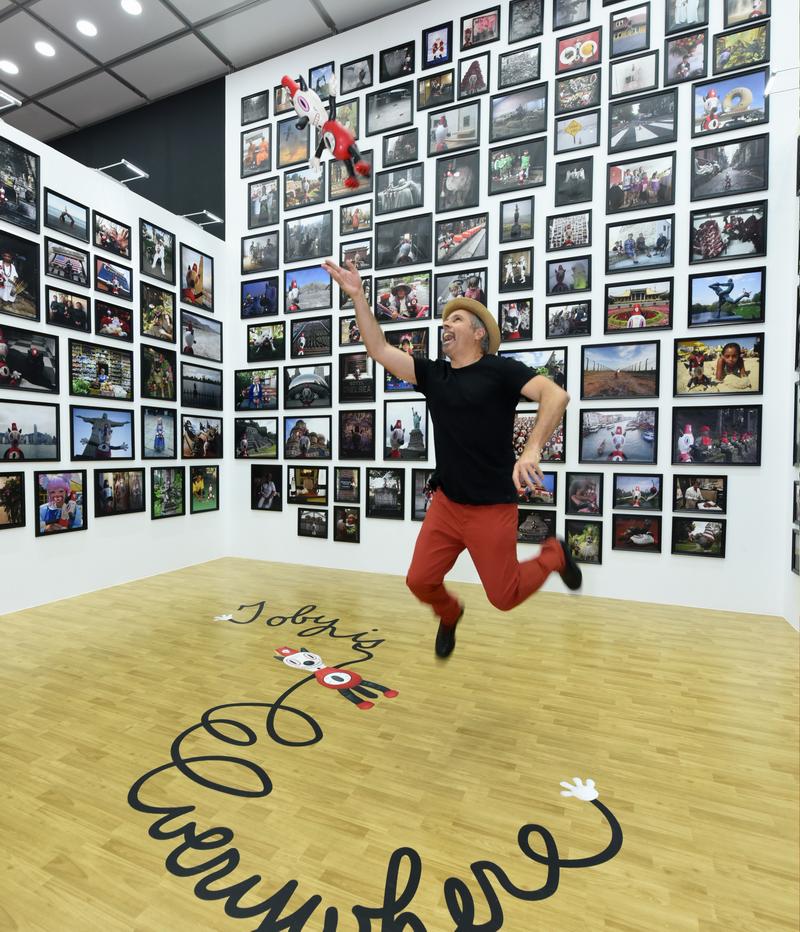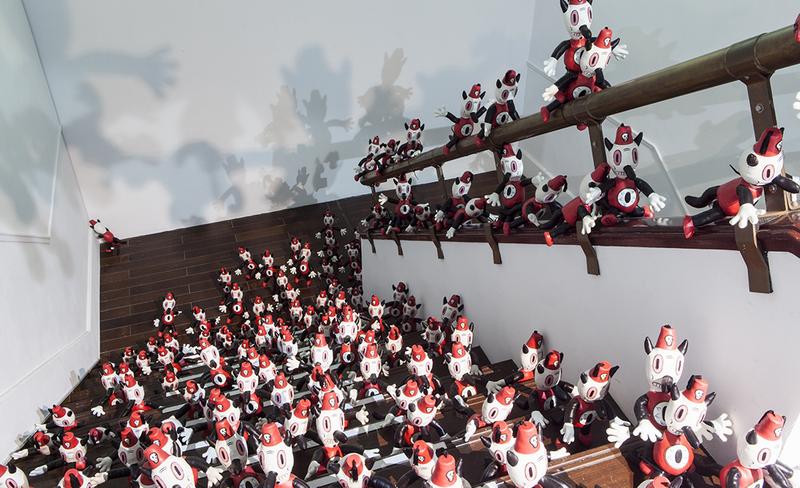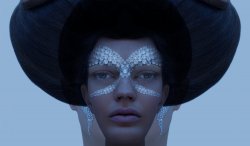- Jobs
- Open Calls
- Events
- Learning
- More
- SUBMIT
WELCOME TO GARY BASEMAN’S UNIVERSE, WHERE WHIMSY CREATURES PLAY IN SINISTER REALMS
Gary Baseman
1. How did you come to discover the artist inside you ?
I don’t remember a time when I didn’t think of myself as an artist. I was very young when I started making or playing with art. My older siblings would bring me animation cels from the Hanna Barbera animation studios to play with, so they helped to turn me onto art when I was hardly out of diapers. Even as a kid, my sister Netta would tell me to sign my name to whatever I created, like what Picasso did, she told me. I wasn’t Picasso, but I was always drawing and was determined to make my mark with my artist name, BASEMAN. My parents would take me to the neighbourhood drug store to buy paper and drawing utensils. My parents didn't know about art stores or we couldn't afford them, but I didn’t need much to make art. I was fine drawing with pencils or markers on regular lined school paper, on the cardboard from packaging or backs of shirts.
" Even as a kid, my sister Netta would tell me to sign my name to whatever I created, like what Picasso did, she told me. "
2. How would you describe your work to someone who has never experienced it before ?
I often describe my work as being a celebration of the beauty of the bittersweetness of life. I explore the human condition, which I know can be considered cliché and romantic, but it’s where my heart is, and where my mind goes in interpreting experiences, thinking about what it means to be human – to feel a range of emotions and needs, from feeling curiosity to desire, from delight to frustration, from ecstasy to utter darkness. Being an artist is being a visual poet. Some people describe my work as looking cartoonish, as I do often make art with characters; this has been my visual language. And I'm determined to create my mark with any chosen media and make it relevant. I view the real world in my own “dream reality,” interpreting real life in my way. Some people are at first mistaken that my art is for children, until they look beyond the first layer and easily see the depth. When I do create work for children, I never draw or talk down to them, but won't put in anything inappropriate.
" I explore the human condition, which I know can be considered cliché and romantic, but it’s where my heart is, and where my mind goes in interpreting experiences, thinking about what it means to be human "

3. In your eyes, what was your most successful project or collaboration? Why ?
The collaboration with Coach has been amazing. I am so honored to continue working with Stuart Vevers, the Creative Director of Coach and the rest of his team. We’ve worked together since 2014. We seem to be on the same page about things, fascinated with different parts of history; and can relate to images and fashion in a way that is very simpatico. I love that we can have an exchange and then produce beautiful items that can be worn or used.
My most successful personal project has been my continued museum exhibitions; The Door is Always Open at the Skirball Cultural Center, then MOCA Taipei, and the K11 Arts Foundation in Shanghai. I'm very proud of creating an 8000 sq ft immersive environment that allows a visitor into my world. Art is important because it is about all of us, and should not alienate only because it's a new language to some. Whether art is narrative or abstract or theoretical, it should invite a viewer to interpret and challenge. People get the impression that art is too important or precious for them. Even the best of modern art, like Rothko wasn't the best for his color theory, it was because he painted human emotion. My museum home not only welcomes guests to sit in my chairs and sofas, which is actually my parents real furniture, but when they leave, they believe the creative door is “always open” to them.
" I'm very proud of creating an 8000 sq ft immersive environment that allows a visitor into my world. Art is important because it is about all of us, and should not alienate only because it's a new language to some. "
4. Tell us a little more about Toby. Was your iconic character inspired by anyone or anything in particular ?
Toby is everyone’s best friend; he is the keeper of secrets and loves you unconditionally. He’s also my long-time travel companion who experiences the globe and cultures and lots of things alongside me. In other words, he’s my alter ego or my avatar and stands in for me at certain moments. The original paintings of Toby were scenes of him being gifted to another as if one is gifting one’s personal intimate self. Toby also manifests himself into anything, he is omnipresent and everywhere as I manifest this in my travel photos. The original real Toby was the first girl I fell in love with as a child. She was an older family friend who would babysit me, but who never treated me like a child; we’d just play like best friends. Toby’s about friendship and unconditional love.

5. What does it mean to be an artist in LA ?
I love Los Angeles. It’s this amazing mecca of creativity that is abundant with artists of all kinds – visual artists from major art schools, filmmakers, designers, musicians. I know a lot of us love it for its beautiful weather, but I think the weather is an amazing elixir for creativity. LA for some reason is the creative tuning fork that resonates around the world. Even as a child, I felt if I created something in LA, the world would experience it. I grew up just blocks from CBS Television City. That big EYE BALL, the all-seeing eye that would see all that happened in the world, but would create content that the entire world would experience. All the studios and media surrounded me. As a child, growing up in the Fairfax district, LA was a Jewish shtetl surrounded by Holocaust survivors. Now, LA is amazing for its variety of cultures. Every neighborhood has its own flavor. I’d like to think we learn from each other, and there’s inspiration on every corner, interesting people. That also means that different communities exist. As much as many of us blend with each other, or blend high and low art, there are still divisions. I still struggle with some, being considered too commercial or too pop. But that’s okay. I will prove all those wrong, or even better, I will prove me right through my life's work.
" I love Los Angeles. It’s this amazing mecca of creativity that is abundant with artists of all kinds – visual artists from major art schools, filmmakers, designers, musicians. I know a lot of us love it for its beautiful weather, but I think the weather is an amazing elixir for creativity. "
6. What are you currently fascinated by and how is it feeding into your work ?
I’ve traveled a lot these past years, immersing myself in other cultures. What do I do with all of these experiences? How do they feed into my art? I have been filling up sketchbooks that I view as works of art in their own right. “Sketchbook” is almost a wrong term since I'm creating drawings and thoughts and not mere sketches. I’m contemplating an exhibition of these books with each book standing as a finished piece of art. Am I escaping another reality (or home), or am I just exposing myself to a broader world so that I can learn more about some “truth”? I studied Communications in college, which still interests me. How do people communicate? What messages are out there? What’s being shared? How has it changed with technology? And especially in this digital age, how authentic are people now? Now that people fabricate their own profiles and often project themselves in a way that aims for likeability only. Are we all compromising on our humanity by fitting into these formal mediums created by technology? I’m fascinated by social media, and hope that it truly helps to move us forward in relationships, but I do wonder (as research has shown), how technology has actually made us less empathetic. That worries me. I want to see people do real things and have real conversations. There is no turning back on technology but as artists, it's our duty to use these mediums to understand the changing human condition.

" I want to see people do real things and have real conversations. There is no turning back on technology but as artists, it's our duty to use these mediums to understand the changing human condition. "
7. Any advice for young artists, hoping to make a name for themselves in the Art World ?
The wide world of art is complex and challenging, and if you really want to live as an artist, you have to work really hard, and just keep producing stuff. You keep trying. I was told early on in my career that I couldn’t become a real illustrator, or a real fine artist, or an animator or photographer, or creator of art performances. But I kept trying; I think the discouragement is what helped me try harder. At the same time, it’s important to be flexible and agile. Keep trying, not to prove others wrong, but to prove yourself right. There’s so much that can be done with any one person’s creativity. There probably isn’t one sector that does not use it. I think it’s important to know yourself, what brings you meaning, where your passion is, what you’re about. I call it, one’s “True Self.”

|
JAN MASNY
Photographer |
SKYE NICOLAS
Post Conceptual Artist |
CHINGHUI YANG
Jewellery Designer |
Eric Galindo
Visual Artist |









